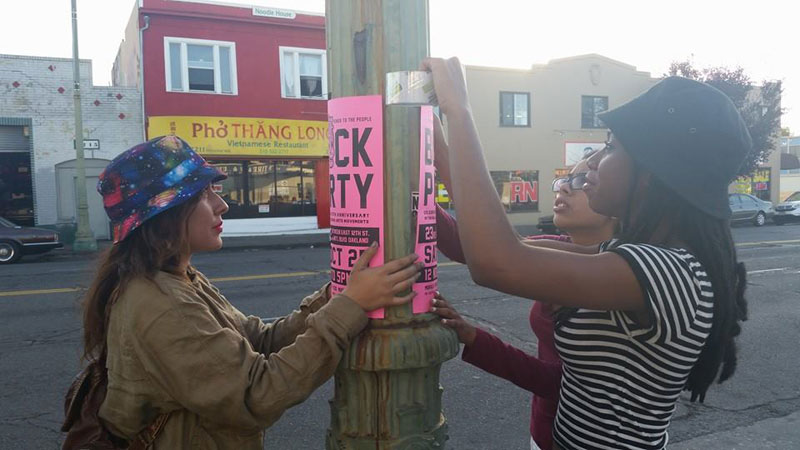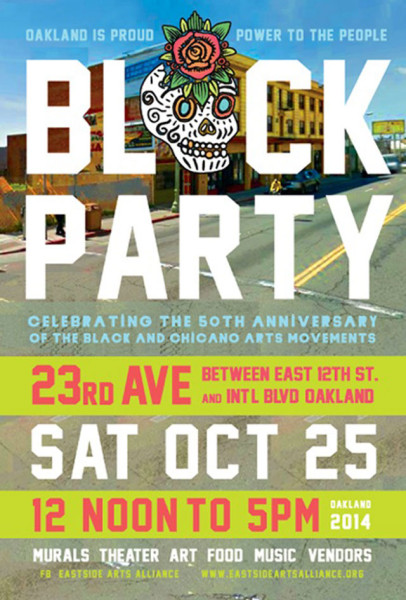Susanne Takehara takes the number 1R bus. It rolls down International Boulevard from deep East Oakland into downtown and all the way to Berkeley. She steps off at 23rd Avenue, near the Eastside Arts Alliance where she’s a founding member.
“Our collective, we live in East Oakland,” Says Susanne Takehara one afternoon sitting on the edge of the Eastside’s low-lit theater stage. “This particular area, lower San Antonio, they call it, is one of the most diverse neighborhoods on all of the West Coast. I hear a minimum of four languages spoken every time I get on the bus. There are 12 that are commonly spoken and something like 30 that have been documented.”
The Bus Rapid Transit will take over the center two lanes of International Boulevard, the main thoroughfare through East Oakland. Meant to serve bus riders in a more efficient way, according to Takehara, corridor development will sink money into roadways, sidewalks, and storefronts but will also serve as an entree for people to move into the area “and in our opinion,” she says, “gentrify our neighborhoods.”
Belief that the bus will bring new developers to one of Oakland’s most ethnically diverse corridors has people on edge. The Oakland is Proud Block Party is the first in a series of events centered around “cultural plazas,” spaces meant to galvanize community and dig residents deeper into place as new eyes begin falling on this traditionally low-rent, pan-ethnic, working-class swathe of East Oakland.
But what makes anyone think a party in the street could be the best approach? Well, it’s sort of worked already.
Elena Serrano, also a founding member of the Eastside Arts Alliance recalls the Eastside’s own beginnings nearly 15 years ago. “In a community that needed housing and jobs and better schools and all that, the community would consistently put all their dots on a cultural center,” says Serrano.
Now a glorious floor-through space, complete with performance stage as well as rentable office and living spaces, the Eastside Arts Alliance was once a “hole in the wall to a hole in the wall,” remembers Serrano. But people wanted something that felt good, she recalls of the Eastside’s birth, something they could celebrate, and somewhere they could build power. Now most of the proposed cultural plaza sites along main intersections of International boulevard are vacant spaces where residents hope to plant the seeds of future community centers by simply occupying them with cultural life.
It’s a strategy to ensure that community residents have a place reserved for them and their cultural interests along one of the town’s most dynamic and lengthy thoroughfares. It’s a cultural mobilization to change the nature of a gentrification that is inevitable and already in motion, and perhaps more importantly, to increase the community health that comes from proximity and visibility of culture.
“If half of your neighborhood is getting evicted and losing their house, it’s bigger than you,” says Serrano, who also hopes to plug local residents into support services offered through the Oakland Sustainable Neighborhood Initiative, a public and private partnership between the City of Oakland and non-profits to promote housing, commercial-economic development and public transportation along the proposed corridor.
An early planning meeting for the plazas brought 20 years of community activism together into one room. East Oakland residents using art and organizing as tools to build healthy communities throughout Oakland revealed a community older than what we know to be today’s Oakland. There was talk of the historic Elmhurst Village; breakfast programs based in a community pride and hope that spread to cover the world; and a cemetery outside of Soweto where Black Panther quotes grace the headstones of anti-apartheid freedom fighters. It was a three-table-wide horseshoe of community members interested in utilizing the arts to make visible a place and a tradition that is at the heart of cultural organizing that spans the globe.
“We’ve seen a lot of speculation in East Oakland,” says Takehara, “We don’t want to be colonized culturally by all these new people that are going to move into the more expensive buildings that haven’t been built yet.”
“We’re concerned with maintaining and keeping the vibrancy of the culture of our neighborhoods here in East Oakland,” says Takehara, “but also improving conditions for folks, so that we can all stay here as opposed to fleeing to the suburbs, which happens with families worried about their young people getting imprisoned or hurt, or killed.”
If all goes well, East Oakland’s newest residents will arrive to bustling neighborhoods already dug in with a sense of power and enough presence to warrant respect in development rather than displacement.
The Oakland is Proud Block Party takes place October 25, 2014 at 23rd and International Blvd. Featured performances include theater from Jose Navarette; jazz with Ms. Faye Carol, Traci Bartlow and Starchild Dance, Fua dia Congo, plus additional special guest artists, children’s activities, and food.
For more information, visit eastsideartsalliance.org.



